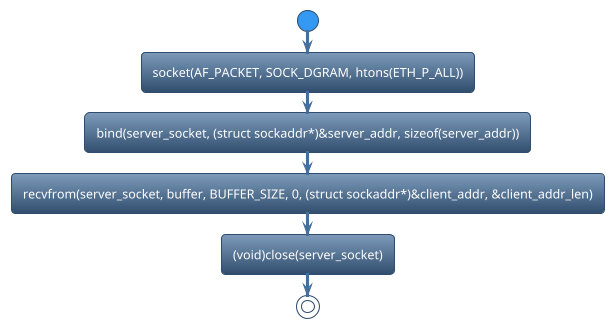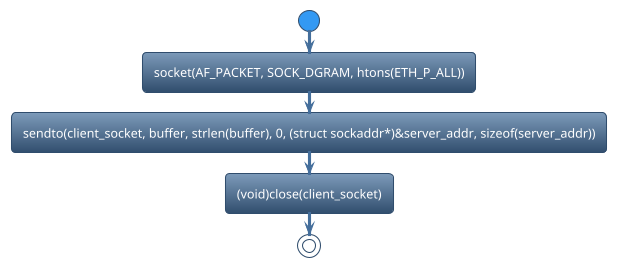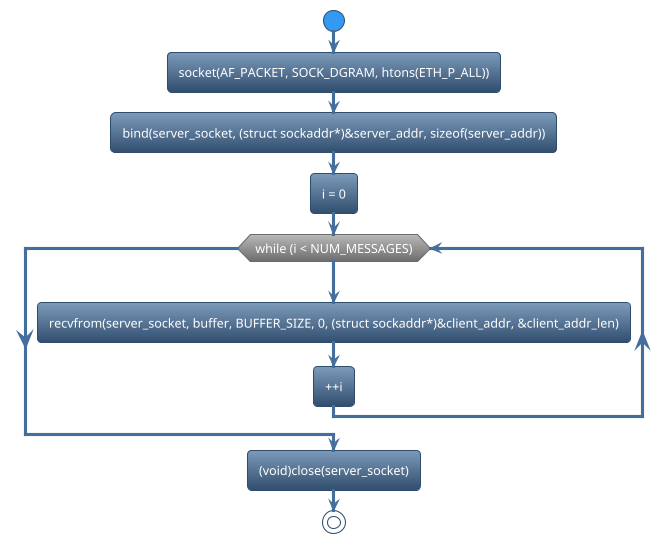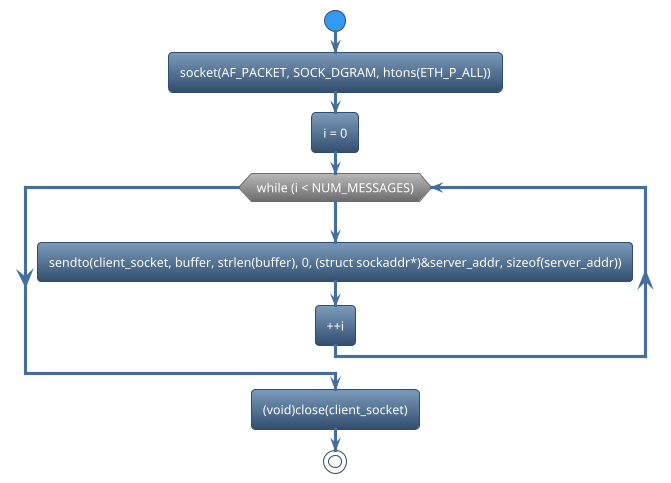Basic example af_packet udp server and client
In this program, you are going to learn
How to create a Socket ?
How to bind a socket ?
How to send a data ?
How to recv a data ?
Topics in this section,
Topics in this section,
Let us answer few basic questions in this socket
What does socket(AF_PACKET, SOCK_DGRAM, htons(ETH_P_ALL)) do?
See Answer
This call creates a packet socket that allows receiving all Ethernet frames,
regardless of destination address, using the recvfrom function.
How can I handle errors when creating a packet socket for receiving all data?
See Answer
Check the return value of the socket function. If it returns -1, use perror to print a descriptive error message.
What kind of errors can occur when using a packet socket for receiving data?
See Answer
Common errors include permission-related errors (EACCES), socket creation failures (ENOMEM), or invalid arguments (EINVAL).
How do I handle errors when binding a packet socket for receiving data?
See Answer
Check the return value of the bind function. If it returns -1,
handle the error by printing a message or taking appropriate corrective action based on the error code.
What is the significance of error code EPERM when dealing with packet sockets?
See Answer
EPERM (Operation not permitted) typically indicates insufficient privileges.
Ensure the program has the necessary permissions to create packet sockets.
How do I handle errors when using recvfrom to receive data with a packet socket?
See Answer
Check the return value of recvfrom. If it returns -1,
handle the error by printing a message or taking appropriate corrective action.
Is it important to close the packet socket on error?
See Answer
Yes, closing the socket is crucial to release system resources. Always follow error-handling best practices and close sockets on error.
Is it possible to receive packets only from a specific network interface with a packet socket?
See Answer
Yes, use the bind function to associate the packet socket with a specific network interface.
How do I handle errors related to socket file descriptor management?
See Answer
When closing sockets, check for errors using close. Handle errors by printing messages or taking corrective actions.

There are many functions used in socket. We can classify those functions based on functionalities.
Create Socket
Bind Socket
Recvfrom data_packet
Close socket
socket()is used to create a new socket. For example,
server_socket = socket(AF_PACKET, SOCK_DGRAM, htons(ETH_P_ALL));
bind()is used to associate the socket with a specific address and port. For example,
ret = bind(server_socket, (struct sockaddr*)&server_addr, sizeof(server_addr));
recvfromis commonly used with UDP sockets, where communication is connectionless. it provides information about the source (sender) of the data, including the sender’s IP address and port number. For example,
ret = recvfrom(server_socket, buffer, BUFFER_SIZE, 0, (struct sockaddr*)&client_addr, &client_addr_len);
closeis used to close the socket To free up system resources associated with the socket. For example,
(void)close(server_socket);
See the full program below,
#include <stdio.h>
#include <stdlib.h>
#include <string.h>
#include <unistd.h>
#include <arpa/inet.h>
#include <signal.h>
#include <netpacket/packet.h>
#include <net/ethernet.h>
#include <net/if.h>
#define BUFFER_SIZE 1024
int server_socket;
int main()
{
int ret;
struct sockaddr_ll
server_addr,
client_addr;
char buffer[BUFFER_SIZE];
server_socket = socket(AF_PACKET,
SOCK_DGRAM,
htons(ETH_P_ALL));
if (server_socket < 0) {
perror("socket");
return -1;
}
memset(&server_addr, 0,
sizeof(server_addr));
server_addr.sll_family = AF_PACKET;
server_addr.sll_protocol =
htons(ETH_P_ALL);
server_addr.sll_ifindex =
if_nametoindex("lo");
ret = bind(server_socket,
(struct sockaddr*)&server_addr,
sizeof(server_addr));
if (ret < 0) {
perror("bind");
(void)close(server_socket);
return -2;
}
printf("UDP is listening\n");
socklen_t client_addr_len =
sizeof(client_addr);
memset(buffer, 0,
sizeof(buffer));
ret = recvfrom(server_socket,
buffer, BUFFER_SIZE, 0,
(struct sockaddr*)&client_addr,
&client_addr_len);
if (ret > 0) {
buffer[ret] = '\0';
printf("Received: %s\n",
buffer);
} else {
perror("recvfrom error");
return - 3;
}
(void)close(server_socket);
return 0;
}
1$ gcc -o server server.c
2
3$ sudo ./server
4
5Received: hello server!

There are many functions used in socket. We can classify those functions based on functionalities.
Create Socket
Sendto data_packet
Close socket
socketis used to create a new socket. For example,
client_socket = socket(AF_PACKET, SOCK_DGRAM, htons(ETH_P_ALL));
sendtois used to send the encoded message to the specified server address and port using a UDP socket. For example,
ret = sendto(client_socket, buffer, strlen(buffer), 0, (struct sockaddr*)&server_addr, sizeof(server_addr));
closeis used to close the socket To free up system resources associated with the socket. For example,
(void)close(client_socket);
See the full program below,
#include <stdio.h>
#include <stdlib.h>
#include <string.h>
#include <unistd.h>
#include <arpa/inet.h>
#include <signal.h>
#include <netpacket/packet.h>
#include <net/ethernet.h>
#include <net/if.h>
#define BUFFER_SIZE 1024
int client_socket;
int main(void)
{
int ret;
struct sockaddr_ll
server_addr;
char buffer[BUFFER_SIZE];
client_socket = socket(AF_PACKET,
SOCK_DGRAM,
htons(ETH_P_ALL));
if (client_socket < 0) {
perror("socket");
return -1;
}
memset(&server_addr, 0,
sizeof(server_addr));
server_addr.sll_family = AF_PACKET;
server_addr.sll_protocol =
htons(ETH_P_ALL);
server_addr.sll_ifindex =
if_nametoindex("lo");
sprintf(buffer, "%s", "hello server!");
ret = sendto(client_socket, buffer,
strlen(buffer), 0,
(struct sockaddr*)&server_addr,
sizeof(server_addr));
if (ret == -1) {
perror("sendto");
return -2;
}
printf("Sentbuffer : %s\n",
buffer);
(void)close(client_socket);
return 0;
}
1$ gcc -o client client.c
2
3$ sudo ./client
4
5Sentbuffer : hello server!

There are many functions used in socket. We can classify those functions based on functionalities.
Create Socket
Bind Socket
Recvfrom data_packet
Close socket
socket()is used to create a new socket. For example,
server_socket = socket(AF_PACKET, SOCK_DGRAM, htons(ETH_P_ALL));
bind()is used to associate the socket with a specific address and port. For example,
ret = bind(server_socket, (struct sockaddr*)&server_addr, sizeof(server_addr));
recvfromis commonly used with UDP sockets, where communication is connectionless. it provides information about the source (sender) of the data, including the sender’s IP address and port number. For example,
ret = recvfrom(server_socket, buffer, BUFFER_SIZE, 0, (struct sockaddr*)&client_addr, &client_addr_len);
closeis used to close the socket To free up system resources associated with the socket. For example,
(void)close(server_socket);
See the full program below,
#include <stdio.h>
#include <stdlib.h>
#include <string.h>
#include <unistd.h>
#include <arpa/inet.h>
#include <signal.h>
#include <netpacket/packet.h>
#include <net/ethernet.h>
#include <net/if.h>
#define BUFFER_SIZE 1024
#define NUM_MESSAGES 10
int server_socket;
int main(void)
{
int ret, i;
struct sockaddr_ll
server_addr,
client_addr;
char buffer[BUFFER_SIZE];
server_socket = socket(AF_PACKET,
SOCK_DGRAM,
htons(ETH_P_ALL));
if (server_socket < 0) {
perror("socket");
return -1;
}
memset(&server_addr, 0,
sizeof(server_addr));
server_addr.sll_family = AF_PACKET;
server_addr.sll_protocol =
htons(ETH_P_ALL);
server_addr.sll_ifindex =
if_nametoindex("lo");
ret = bind(server_socket,
(struct sockaddr*)&server_addr,
sizeof(server_addr));
if (ret < 0) {
perror("bind");
(void)close(server_socket);
return -2;
}
printf("UDP is listening\n");
socklen_t client_addr_len =
sizeof(client_addr);
i = 0;
while (i < NUM_MESSAGES) {
memset(buffer, 0,
sizeof(buffer));
ret = recvfrom(server_socket,
buffer, BUFFER_SIZE, 0,
(struct sockaddr*)&client_addr,
&client_addr_len);
if (ret > 0) {
buffer[ret] = '\0';
printf("Received: %s\n",
buffer);
} else if (ret < 0) {
perror("recvfrom error");
break;
}
++i;
}
(void)close(server_socket);
return 0;
}
1$ gcc -o server server.c
2
3$ sudo ./server
4
5UDP is listening
6Received: hello server!
7Received: hello server!
8Received: hello server!
9Received: hello server!
10Received: hello server!
11Received: hello server!
12Received: hello server!
13Received: hello server!
14Received: hello server!
15Received: hello server!

There are many functions used in socket. We can classify those functions based on functionalities.
Create Socket
Sendto data_packet
Close socket
socketis used to create a new socket. For example,
client_socket = socket(AF_PACKET, SOCK_DGRAM, htons(ETH_P_ALL));
sendtois used to send the encoded message to the specified server address and port using a UDP socket. For example,
ret = sendto(client_socket, buffer, strlen(buffer), 0, (struct sockaddr*)&server_addr, sizeof(server_addr));
closeis used to close the socket To free up system resources associated with the socket. For example,
(void)close(client_socket);
See the full program below,
#include <stdio.h>
#include <stdlib.h>
#include <string.h>
#include <unistd.h>
#include <arpa/inet.h>
#include <signal.h>
#include <netpacket/packet.h>
#include <net/ethernet.h>
#include <net/if.h>
#define BUFFER_SIZE 1024
#define NUM_MESSAGES 10
int client_socket;
int main(void)
{
int ret, i;
struct sockaddr_ll
server_addr;
char buffer[BUFFER_SIZE];
client_socket = socket(AF_PACKET,
SOCK_DGRAM,
htons(ETH_P_ALL));
if (client_socket < 0) {
perror("socket");
return -1;
}
memset(&server_addr, 0,
sizeof(server_addr));
server_addr.sll_family = AF_PACKET;
server_addr.sll_protocol =
htons(ETH_P_ALL);
server_addr.sll_ifindex =
if_nametoindex("lo");
i = 0;
while (i < NUM_MESSAGES) {
sprintf(buffer, "%s", "hello server!");
ret = sendto(client_socket, buffer,
strlen(buffer), 0,
(struct sockaddr*)&server_addr,
sizeof(server_addr));
if (ret < 0) {
perror("sendto");
break;
}
printf("Sentbuffer : %s\n",
buffer);
++i;
}
(void)close(client_socket);
return 0;
}
1$ gcc -o client client.c
2
3$ sudo ./client
4
5Sentbuffer : hello server!
6Sentbuffer : hello server!
7Sentbuffer : hello server!
8Sentbuffer : hello server!
9Sentbuffer : hello server!
10Sentbuffer : hello server!
11Sentbuffer : hello server!
12Sentbuffer : hello server!
13Sentbuffer : hello server!
14Sentbuffer : hello server!
Default Domain:
By default, the socket is configured to work in the
AF_PACKETdomain, handling all types of network data.
Additional Domain Support:
We expand the socket’s capabilities to also function in the
PF_PACKETdomain, allowing it to operate similarly toAF_PACKET.
Socket Creation:
We set up a network connection point known as a socket using
socket(PF_PACKET, SOCK_DGRAM, IPPROTO_UDP).
Working Scenario:
Despite the change in domain to
PF_PACKET, the socket continues to operate the same way, handling general network data.
Default Protocol Support:
By default, the socket is configured to support the capture of all Ethernet frames
(ETH_P_ALL protocol).
Additional Protocol:
The socket is designed to seamlessly support an additional protocol, namely
ETH_P_PAE.
Socket Creation:
A socket is created using the
socket(AF_PACKET, SOCK_DGRAM, htons(ETH_P_PAE))call.
Working Scenario:
Despite the change in protocol to
ETH_P_PAE, the overall working scenario of the socket remains consistent.
Socket API |
Learning |
|---|---|
socket |
Create a new socket |
bind |
Associate the socket with a specific address and port |
recvfrom |
It provides information about the source (sender) of the data, including the sender’s IP address and port number. |
sendto |
Send the encoded message to the specified server address and port using a UDP socket. |
Previous topic
Current topic
Next topic
Other sockets
Other IPCs